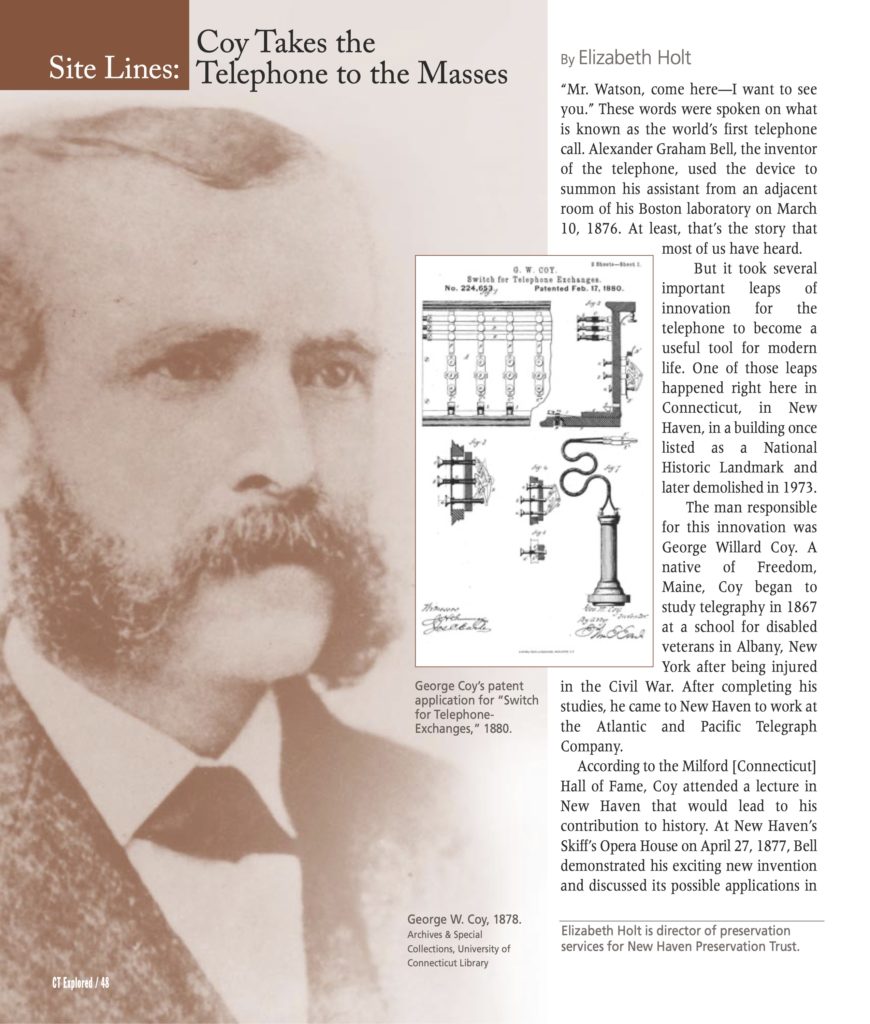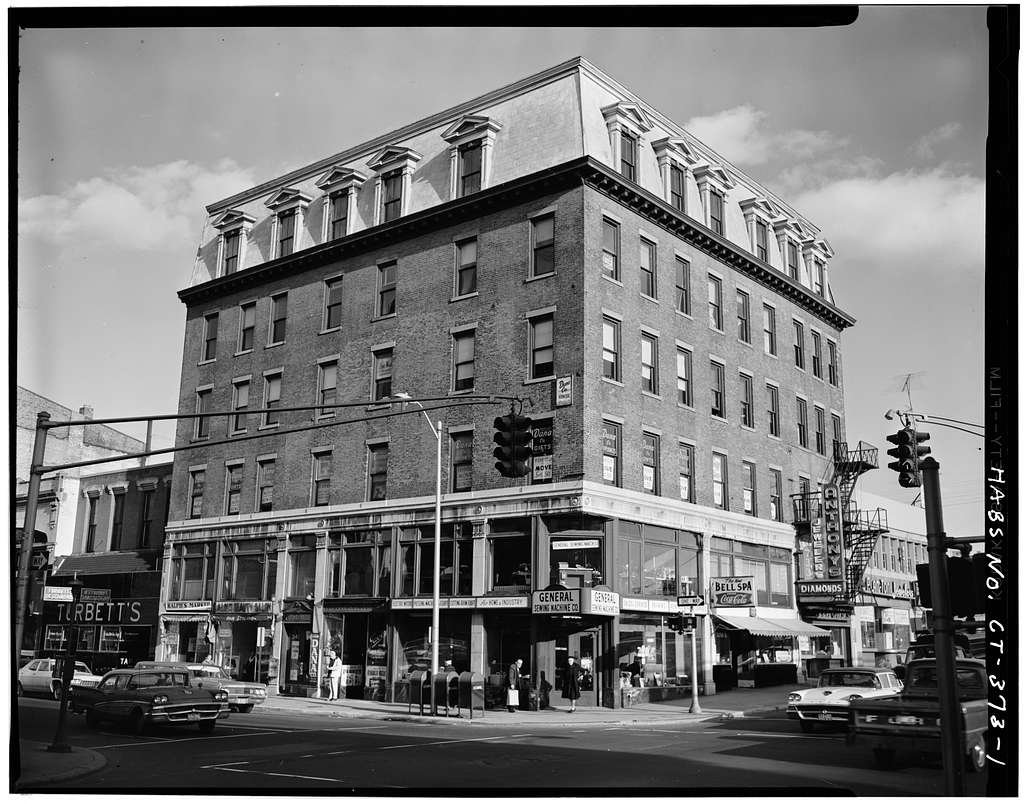
George W. Coy, 1878.
Archives & Special Collections, University of Connecticut Library; (inset) George Coy’s patent application , 1880.
By Elizabeth Holt
(c) Connecticut Explored Inc. Winter 2020-2021
Subscribe/Buy the Issue!
“Mr. Watson, come here—I want to see you.” These words were spoken on what is known as the world’s first telephone call. Alexander Graham Bell, the inventor of the telephone, used the device to summon his assistant from an adjacent room of his Boston laboratory on March 10, 1876. At least, that’s the story that most of us have heard.
But it took several important leaps of innovation for the telephone to become a useful tool for modern life. One of those leaps happened right here in Connecticut, in New Haven, in a building once listed as a National Historic Landmark and later demolished in 1973.
The man responsible for this innovation was George Willard Coy. A native of Freedom, Maine, Coy began to study telegraphy in 1867 at a school for disabled veterans in Albany, New York after being injured in the Civil War. After completing his studies, he came to New Haven to work at the Atlantic and Pacific Telegraph Company.
According to the Milford [Connecticut] Hall of Fame, Coy attended a lecture in New Haven that would lead to his contribution to history. At New Haven’s Skiff’s Opera House on April 27, 1877, Bell demonstrated his exciting new invention and discussed its possible applications in business and trade. While impressive for its time, the telephone was initially impractical. Telephones had to be sold in pairs and hard wired between two specific locations. Early adopters connected the owner’s home and business, for example. Installation was labor intensive, especially when compared to the relatively small payoff.
A three-way call demonstrated by Bell between the opera house, a telephone in Middletown, and one in Hartford—presumably all direct wired—inspired Coy to create a method by which the telephone could be more widely used, according to “Site of the First Telephone Exchange” on the National Park Service’s National Historic Landmarks website. First, Coy applied for a Bell Telephone Company franchise for New Haven and Middlesex Counties. Along with investors Herrick P. Frost and Walter Lewis, he then established the District Telephone Company of New Haven on January 15, 1878.

According to the National Park Service, in 1878 George Coy installed the world’s first telephone exchange in New Haven’s Boardman Building in the storefront with the awning to the right, shown here c 1930s. Historic American Building Survey, Library of Congress
Coy then invented a switchboard, which he installed in the storefront offices of the District Telephone Company in the Boardman Building, on the northeast corner of State and Chapel streets. Coy’s switchboard was constructed of, according to an unnamed source on the NPS site, “carriage bolts, handles from teapot lids and bustle wire.” On January 28 the company began operation of the world’s first telephone exchange. Two years later, Coy received a patent on February 17, 1880.
Despite its haphazard construction, the switchboard was a success. Within a month, the company published the world’s first telephone directory, listing 50 subscribers. The company expanded to cover all of Connecticut and western Massachusetts and was renamed Southern New England Telephone in 1882.
National Historic Landmarks are recognized for their outstanding national historical significance. Of more than 90,000 listings on the National Register of Historic Places, only about 2,500 have been recognized as National Historic Landmarks, a clear indication of their level of importance. For its significant role in the country’s history, the Boardman Building was determined eligible as a National Historic Landmark on January 29, 1964 and was listed the following year
Its landmark designation, however, wasn’t enough to ensure its survival. In 1968 the building, known by then as the Metropolitan Building, was purchased by the New Haven Redevelopment Agency with the intent to demolish it and build a parking garage. Though it took another five years for the agency’s plan to come to fruition, the Metropolitan Building was demolished in 1973, and a National Historic Landmark was lost forever.
Today New Haven boasts 11 National Historic Landmarks, from the New Haven Green to the Yale Bowl [See “Destination: Ingalls Rink and the Yale Bowl,” Fall 2009], accounting for a wide range of historic significance. But what if there were 12? Much has changed in the eyes of the public where historic landmarks are concerned. Though National Register designation is not a fail-safe protection against demolition, it’s likely that the people of New Haven would not stand for the loss of one of their historic landmarks in 2020.
What if the story of Alexander Graham Bell’s telephone was more widely paired with that of George Willard Coy’s development in New Haven of the first telephone exchange? So often in history, it is the initial sparks of innovation that are remembered, as in the case of the telephone. But without the work by Coy at the Boardman Building in New Haven to make Bell’s invention scalable to large numbers of users, the telephone might have developed on a much different trajectory.
Elizabeth Holt is director of preservation services for New Haven Preservation Trust.
GO TO NEXT STORY
 Connecticut Explored received support for this publication from the State Historic Preservation Office of the Department of Economic and Community Development with funds from the Community Investment Act of the State of Connecticut.
Connecticut Explored received support for this publication from the State Historic Preservation Office of the Department of Economic and Community Development with funds from the Community Investment Act of the State of Connecticut.
